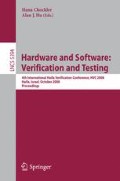Abstract
Closing the feedback loop from coverage data to the stimuli generator is one of the main challenges in the verification process. Typically, verification engineers with deep domain knowledge manually prepare a set of stimuli generation directives for that purpose. Bayesian networks based CDG (coverage directed generation) systems have been successfully used to assist the process by automatically closing this feedback loop. However, constructing these CDG systems requires manual effort and a certain amount of domain knowledge from a machine learning specialist. We propose a new method that boosts coverage at early stages of the verification process with minimal effort, namely a fully automatic construction of a CDG system that requires no domain knowledge. Experimental results on a real-life cross-product coverage model demonstrate the efficiency of the proposed method.
Access this chapter
Tax calculation will be finalised at checkout
Purchases are for personal use only
Preview
Unable to display preview. Download preview PDF.
References
Wile, B., Goss, J.C., Roesner, W.: Comprehensive Functional Verification -The Complete Industry Cycle. Elsevier, Amsterdam (2005)
Piziali, A.: Functional Verification Coverage Measurement and Analysis. Springer, Heidelberg (2004)
Fine, S., Ziv, A.: Coverage directed test generation for functional verification using Bayesian networks. In: Proceedings of the 40th Design Automation Conference, pp. 286–291 (2003)
Fournier, L., Ziv, A.: Using virtual coverage to hit hard-to-reach events. In: Yorav, K. (ed.) HVC 2007. LNCS, vol. 4899, pp. 104–119. Springer, Heidelberg (2008)
Wagner, I., Bertacco, V., Austin, T.: Microprocessor verification via feedback-adjusted Markov models. IEEE Transactions on Computer-Aided Design of Integrated Circuits and Systems 26(6), 1126–1138 (2007)
Bose, M., Shin, J., Rudnick, E.M., Dukes, T., Abadir, M.: A genetic approach to automatic bias generation for biased random instruction generation. In: Proceedings of the 2001 Congress on Evolutionary Computation CEC 2001, pp. 442–448 (2001)
Hsiou-Wen, H., Eder, K.: Test directive generation for functional coverage closure using inductive logic programming. In: Proceedings of the High-Level Design Validation and Test Workshop, pp. 11–18 (2006)
Pearl, J.: Probabilistic Reasoning in Intelligent Systems: Network of Plausible Inference. Morgan Kaufmann, San Francisco (1988)
Fine, S., Ziv, A.: Enhancing the control and efficiency of the covering process. In: Proceedings of the High-Level Design Validation and Test Workshop, pp. 96–101 (2003)
Fine, S., Freund, A., Jaeger, I., Mansour, Y., Naveh, Y., Ziv, A.: Harnessing machine learning to improve the success rate of stimuli generation. IEEE Transactions on Computers 55(11), 1344–1355 (2006)
Cooper, G.F., Herskovits, E.: A Bayesian method for the induction of probabilistic networks from data. Journal of Machine Learning 9(4), 309–347 (1992)
Laskey, K.B., Myers, J.W.: Population markov chain monte carlo. Journal of Machine Learning 50(1-2), 175–196 (2003)
Chickering, D.: Optimal structure identification with greedy search. Journal of Machine Learning Research 3, 507–554 (2002)
Friedman, N.: The Bayesian structural EM algorithm. In: Proc. 14th Conf. on Uncertainty in Artificial Intelligence, pp. 129–138 (1998)
Ur, S., Yadin, Y.: Micro-architecture coverage directed generation of test programs. In: Proceedings of the 36th Design Automation Conference, pp. 175–180 (1999)
Rusakov, D., Geiger, D.: Asymptotic model selection for naive Bayesian networks. J. Mach. Learn. Res. 6, 1–35 (2005)
Guyon, I., Elisseeff, A.: An introduction to variable and feature selection. J. Mach. Learn. Res. 3, 1157–1182 (2003)
Kohavi, R., John, G.H.: Wrappers for feature subset selection. Artif. Intell. 97(1-2), 273–324 (1997)
Cover, T.M., Thomas, J.A.: Elements of Information Theory. John Wiley, Chichester (1991)
Heckerman, D.: A tutorial on learning with Bayesian networks. Technical report, Microsoft Research, Redmond, Washington (1996)
Author information
Authors and Affiliations
Editor information
Editors and Affiliations
Rights and permissions
Copyright information
© 2009 Springer-Verlag Berlin Heidelberg
About this paper
Cite this paper
Baras, D., Fournier, L., Ziv, A. (2009). Automatic Boosting of Cross-Product Coverage Using Bayesian Networks. In: Chockler, H., Hu, A.J. (eds) Hardware and Software: Verification and Testing. HVC 2008. Lecture Notes in Computer Science, vol 5394. Springer, Berlin, Heidelberg. https://doi.org/10.1007/978-3-642-01702-5_10
Download citation
DOI: https://doi.org/10.1007/978-3-642-01702-5_10
Publisher Name: Springer, Berlin, Heidelberg
Print ISBN: 978-3-642-01701-8
Online ISBN: 978-3-642-01702-5
eBook Packages: Computer ScienceComputer Science (R0)

